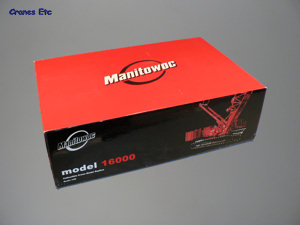 | | The Manitowoc box. | 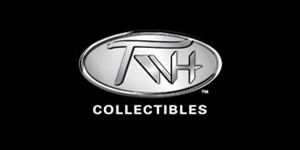 | 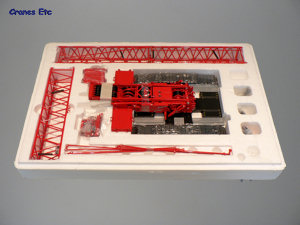 | | The bottom tray. | 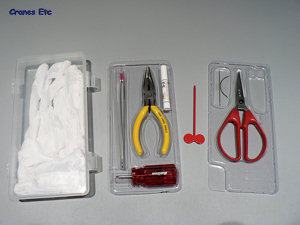 | | The toolkit: gloves, screwdriver, tweezers, pliers, superglue, scissors, needles and operating key. | 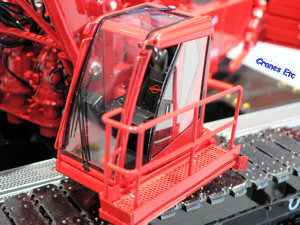 | | 'Vision' cab with sliding door and Manitowoc name on the seat back. | 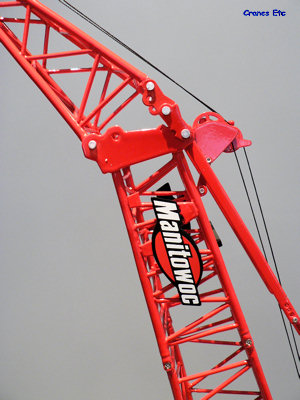 | | Connections at the boom top are riveted so not easily undone, and there are no sheaves for heavy lifting. | 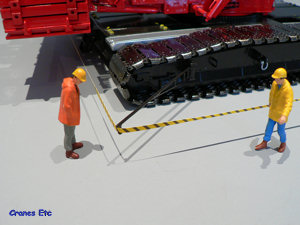 | | The crawler frames have fold out booms which can be used to demarcate a danger area around the crane. | 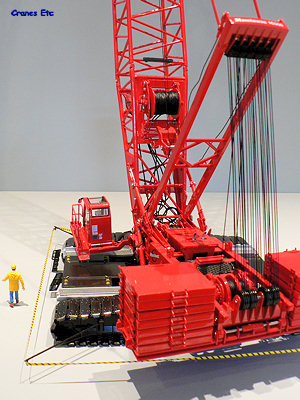 | | Rear counterweight and luffing gear. The slabs do not stack perfectly though. | 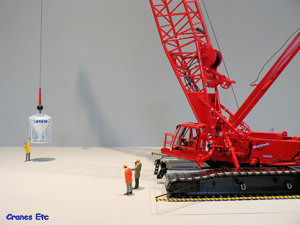 | | Lifting the Gar-Bro concrete skip. Using the 16000 is not an efficient way to place concrete! | 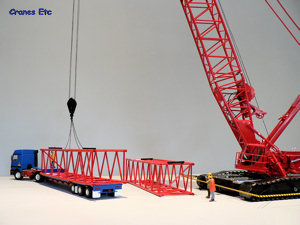 | | Offloading a boom section. | 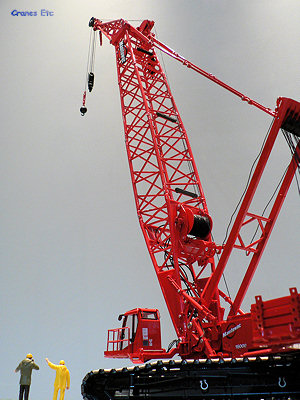 | | The 16000 configured with a very short boom. |
| The Manitowoc 16000 is a 400t capacity crawler crane which can lift up to 90m (295ft) on the main boom and up to 132m (432ft) with a luffing jib. The model is supplied in a configuration with an Extended Upper Boom Point intended for lifting at height on the main boom.
Packaging
The model comes in a Manitowoc branded box and the model parts are held within two expanded polystyrene trays. The arrangement of the trays is a little untidy but the parts are all securely held and there were no missing or defective pieces on the review model.
Included with the model is a 40 page manual. This includes the standard Manitowoc product brochure which has lots of information about the real machine including load charts. The rest of the manual includes assembly instructions for the model. These are very good with a complete illustrated parts list and a good series of clear pictures with English instructions. A supplemental sheet was included with the review model which detailed the fixing of the access steps to the carbody centre counterweight.
Also included is an excellent toolkit which is the same as the one provided with the Manitowoc 18000 model. A further neat touch is the provision of a few spare crawler track pads which might be useful if one ever gets broken.
Assembly of the model is not a difficult task as much of it is pre-assembled in the factory. It would be best to allow a couple of hours and as always with large crane models, a degree of patience is necessary to ease parts into place and to complete the reeving.
Detail
Overall, the model is very detailed and in this regard it follows in the footsteps of the Manitowoc 18000 model. The crawler tracks and body are all pre-assembled as one piece, and disassembly was not attempted as part of this review. The crawler tracks are the same as those used on the Manitowoc 18000. They are excellent and heavy, and sit on spring-loaded sprockets on the track frames. There are plenty of details on the track frame too, with fold-out booms which can be used to demarcate a safety zone around the crane by attaching hazard tape which is also included with the model. Between the track frames there are excellent perforated walkway panels and detailed ballast boxes. Delicate perforated steps provide access to the deck and there is a heavy toothed slewing ring.
The operator's cab is fully detailed with windscreen wipers and fine gauge grab handles, and a door mirror. The door to the cab is delicate and slides open to reveal a detailed interior complete with the 'Manitowoc' logo printed on the back of the seat. At the rear of the cab various notices are replicated with tiny writing. Outside the cab there is an excellent mesh walkway and handrails, and cabling which runs to the body.
At the front of the crane body two fine slewing motors are modelled complete with power cables leading from their tops. Behind these are some connection points for hydraulic hosing which runs from the winch drum in the boom butt section. Immediately behind the cab there are hydraulic jacks (two on each side) which are used to jack the rotating bed assembly up when installing the carbody (the under frame and slewing mechanism). They swing out and can rotate into position, but are non-functional.
At the rear of the crane body, counterweight trays hang off each side which have one slab permanently fixed in each tray. The slabs have both step irons and lifting lugs so realistic loading of the slabs can be posed although they do not stack perfectly due to slight manufacturing tolerance differences in the way the lifting lugs are fitted to each slab. Within the crane body an engine block is present with radiator assemblies being the visible parts. Hoses run inside the body and lead to very well detailed luffing winches. A pair of fine exhaust pipes are modelled.
Turning to the boom connection point, large silver screws are used for both the boom and the moving mast and these look slightly obtrusive on the model. The moving mast has a couple of lifting strops attached which are presumably replicating the system for lifting the boom butt using the moving mast during assembly. However the strops are riveted in position so this cannot be posed. The pulley sheaves associated with the luffing gear are metal. The boom and jib sections of the crane have chord members which are genuine tube shapes so are very convincing. The geometry is very good and is a significant improvement over the Manitowoc 18000 model and no doubt a number of lessons have been learned to produce the 16000. Some very minor kinks can be seen in individual chord members but overall the boom parts are very straight, and joining the boom sections uses small screws which are strong and positive. Many of the boom sections have replica timber protection strips applied.
The pendants (straps) are made of thin metal strips with screwed connections which work well but are easily bent, and when this occurs it is more difficult to get them perfectly straight again. When rigging the boom at full length there is an intermediate support point from the pendants to the boom and this is modelled well. Within the boom butt section is a winch which is very good in terms of detail and is complete with hydraulic hosing which connects through into the main crane body. Pulleys on the model are first rate as they have spokes and turn freely on their axles. The boom top has metal Manitowoc sign boards although surprisingly there are no sheaves in this part so the crane cannot be posed in a heavy lift configuration.
The model comes with an extended boom point which has excellent spoked sheaves and rollers. It is however riveted to the boom top so it represents the only display option available. Two hooks are supplied. The main block is metal and has 3 sheaves and a swivelling hook with safety catch. The whip line is a typical headache ball hook.
Features
The crawler tracks work very well. Each track frame has fold out booms to enable a safety zone to be marked and this feature makes for a convincing display, although not quite enough hazard tape was supplied with the review model to surround it completely.
Rotation of the crane is very smooth. The cab can be rotated horizontally for transport and can be tilted to provide operator comfort, and an opening cab door provides interest. The walkway between the track frames is hinged to provide access to the track drives and this is a very nice touch.
To operate the model a tool is provided for the winches in the crane body. The winch drum for luffing the boom can be worked with the tool but the layout of the crane means that the counterweight slabs on one side have to be removed. There is no positive brake on the drum although there is enough friction to hold the boom above a 30° angle comfortably. A little less satisfactory is that although the luffing mechanism is helpfully reeved in the factory it consists of a separate line of string on each half of the luffing gear. The review model was reeved with more string on one drum than the other which meant that in some positions one of the lines loses some tension. The keen collector could correct this by unreeving the model and re-reeving it but this is easily a couple of hours of work. The winch in the crane body has a spring loaded drum which is fine. The boom mounted winch has no brake at all which means it can barely hold more weight than the hook block. It is a pity this aspect continues from the 18000 model although the reality is that the collector can easily find a way to jam the winch one way or another and pose a load being lifted.
A few display options exist for the model with the large number of boom sections provided so if desired a very large model can be built. However the stability of the model becomes an issue of the boom is not fairly vertical so do not expect to be able to pose the model lifting at a big radius. In some respects it has much in common with the 18000 model in that it is not easily broken down to represent transport loads, so that is not a ready display option. Also a little more flexibility at the boom top would have permitted heavy lift display options for relatively little additional cost.
Quality
This model is another in the line of very high quality TWH models in terms of detail provided, and there is almost a complete absence of plastic. In this sense it is a museum-quality model. The paintwork and graphics on the model are all first rate. There are relatively minor issues in the boom fabrication tolerances compared to the earlier 18000 model which is a good step forward.
In terms of the engineering of some of the features a slightly more functional approach would have made the model outstanding.
Price
The model is both impressively large and high quality and is a strong value overall bearing in mind what it offers.
Overall
As the second in the line of Manitowoc heavy crawler crane models it is a very good model overall, and looks very impressive because of the detail and size. The quality of the boom fabrications has improved. In terms of meeting an objective of being a museum-quality replica it is a success and will satisfy collectors. With a little more attention on the functionality and flexibility, the model could have been outstanding, with a heavy lift option for the main boom, brakes on the winches, and the ability to strip the model down more being particular enhancements. Overall the Manitowoc 16000 is a first class model.
Footnotes
The model first appeared at the Nuremberg Toy Fair in 2007. The following versions were produced: Manitowoc Red - run of 2400 Dielco (Orange and Black) - run of 325 Kiewit (Yellow and Black) - run of 325. In 2010 a compact edition was produced which had fewer boom sections and was intended to be a more easily displayed.
|
| |
| 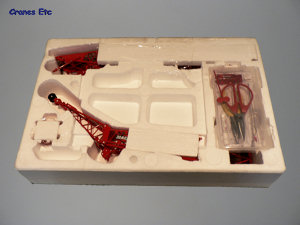 | | The top tray. | 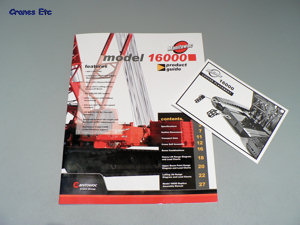 | | The brochure / instruction manual and insert card. | 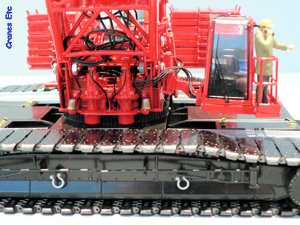 | | Tremendous detail at the boom pivot point with hydraulic cables everywhere. | 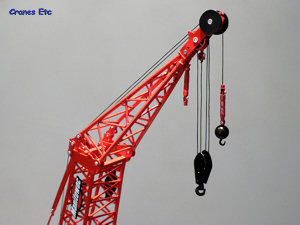 | | The Extended Upper Boom with swivel hook and weight ball and 100t hook block. | 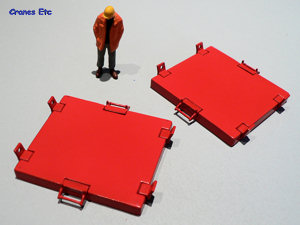 | | |  | | Detailed metal tracks and frames. | 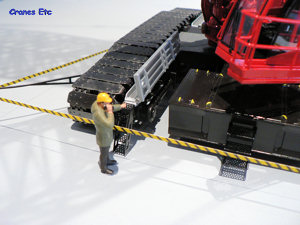 | | Platforms are hinged to provide access to the crawler drive gear. | 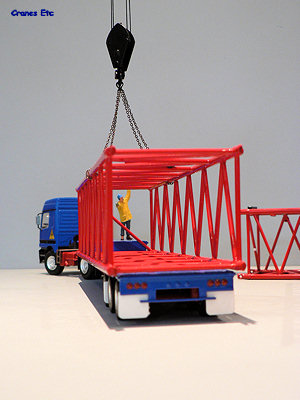 | | Boom sections are straight. This one is loaded on a Talbert Trailer. | 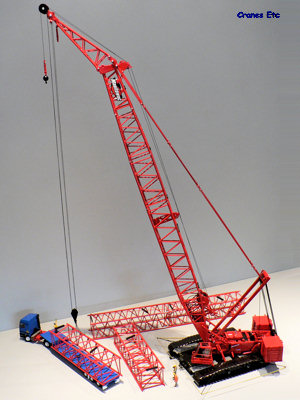 | | Short rigged boom with plenty of sections left over that could be inserted to make a very big model. | 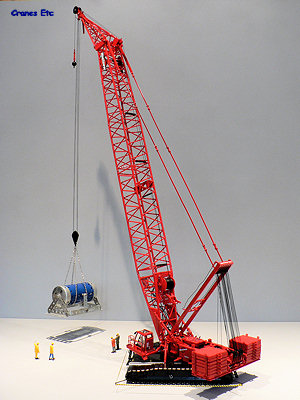 | | Lifting a piece of heavy equipment. |
|

